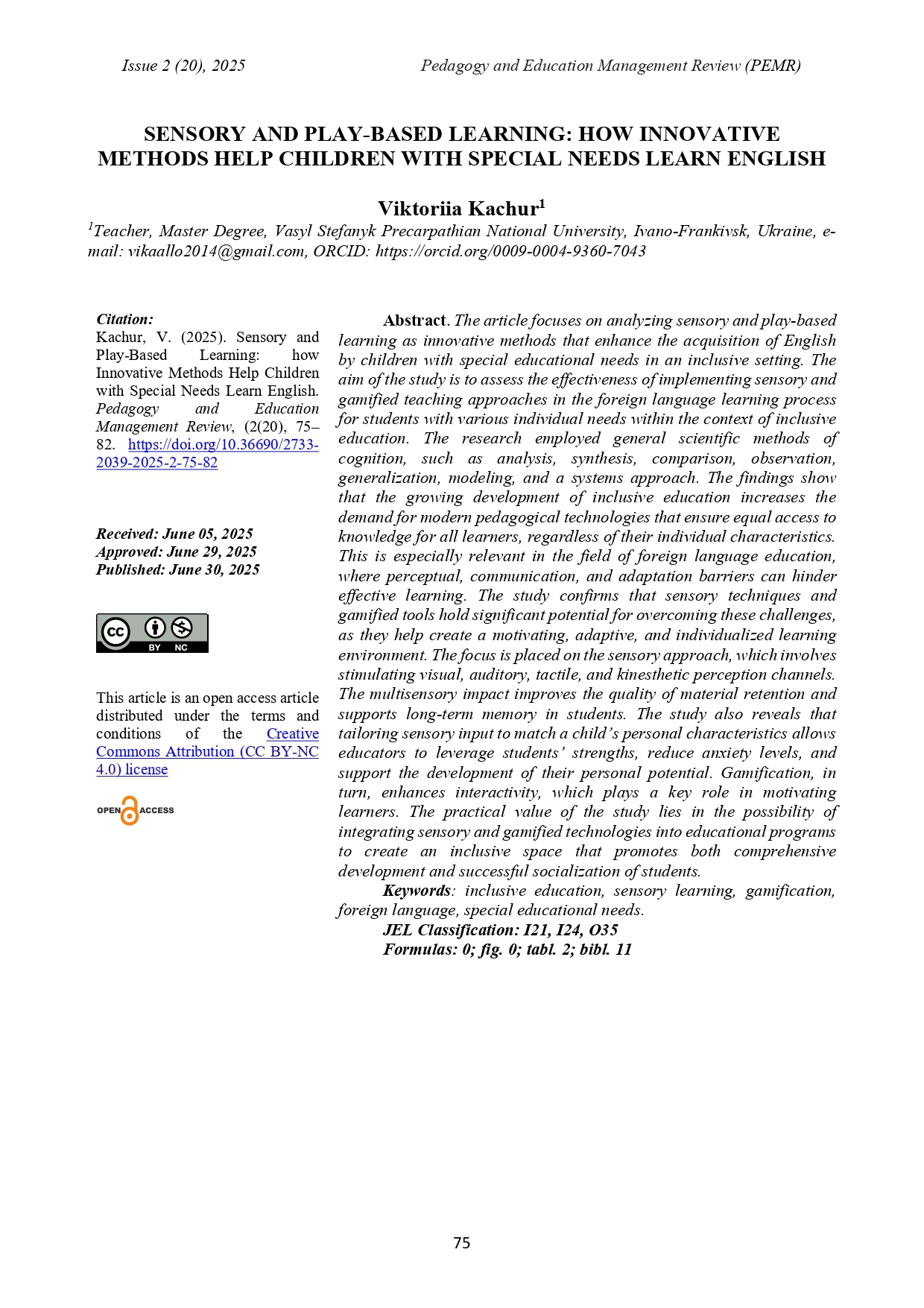SENSORY AND PLAY-BASED LEARNING: HOW INNOVATIVE METHODS HELP CHILDREN WITH SPECIAL NEEDS LEARN ENGLISH
DOI:
https://doi.org/10.36690/2733-2039-2025-2-75-82Keywords:
inclusive education, sensory learning, gamification, foreign language, special educational needsAbstract
The article focuses on analyzing sensory and play-based learning as innovative methods that enhance the acquisition of English by children with special educational needs in an inclusive setting. The aim of the study is to assess the effectiveness of implementing sensory and gamified teaching approaches in the foreign language learning process for students with various individual needs within the context of inclusive education. The research employed general scientific methods of cognition, such as analysis, synthesis, comparison, observation, generalization, modeling, and a systems approach. The findings show that the growing development of inclusive education increases the demand for modern pedagogical technologies that ensure equal access to knowledge for all learners, regardless of their individual characteristics. This is especially relevant in the field of foreign language education, where perceptual, communication, and adaptation barriers can hinder effective learning. The study confirms that sensory techniques and gamified tools hold significant potential for overcoming these challenges, as they help create a motivating, adaptive, and individualized learning environment. The focus is placed on the sensory approach, which involves stimulating visual, auditory, tactile, and kinesthetic perception channels. The multisensory impact improves the quality of material retention and supports long-term memory in students. The study also reveals that tailoring sensory input to match a child’s personal characteristics allows educators to leverage students’ strengths, reduce anxiety levels, and support the development of their personal potential. Gamification, in turn, enhances interactivity, which plays a key role in motivating learners. The practical value of the study lies in the possibility of integrating sensory and gamified technologies into educational programs to create an inclusive space that promotes both comprehensive development and successful socialization of students.
Downloads
References
Costley, K. C. (2014). The positive effects of technology on teaching and student learning. Education, Computer Science. Retrieved from: https://eric.ed.gov/?id=ED554557
Drexler, D. W. (2010). The networked student model for construction of personal learning environments: Balancing teacher control and student autonomy. Australian Journal of Educational Technology, 26(3), 369-385. DOI: https://doi.org/10.14742/ajet.1081
Learn English through games. (n.d.). Cambridgeenglish. Retrieved from: https://www.cambridgeenglish.org/learning-english/parents-and-children/your-childs-interests/learn-english-through-games/
Marco, E. J., Hinkley, L. B., Hill, S. S., & Nagarajan, S. S. (2011). Sensory processing in autism: A review of neurophysiologic findings. Pediatric Research, 69(5 Pt 2), 48R–54R. DOI: https://doi.org/10.1203/PDR.0b013e3182130c54
National Center for Education Statistics (2024). Annual Reports and Information Staff. Students With Disabilities. Retrieved from: https://nces.ed.gov/programs/coe/indicator/cgg/students-with-disabilities?utm_source=chatgpt.com
Online Learning College. (2024). Innovative teaching strategies for students with learning disabilities. Retrieved from: https://online-learning-college.com/knowledge-hub/care/innovative-teaching-strategies-for-students-with-learning-disabilities/?srsltid=AfmBOore3z82G3Q3kaap5YT4VUpzkk-BulXQaiBZO39mZIUr2_PzW8W_
Ramadani, R. (2024). Enhancing English learning for special needs students through technology. Asian Journal of Research in Computer Science, 17(6), 126-134. DOI: https://doi.org/19734/ajrcos/2024/v17i6462
Rizk, J., & Hillier, C. (2022). Digital technology and increasing engagement among students with disabilities: Interaction rituals and digital capital. Computers and Education Open, 3, 100099. DOI: https://doi.org/10.1016/j.caeo.2022.100099
Sousa, D. A. (2011). How the brain learns (4th ed.). Thousand Oaks, CA: Corwin.
Supriatna, A., & Ediyanto, E. (2021). The implementation of multisensory technique for children with dyslexia. IJDS: Indonesian Journal of Disability Studies, 8, 279-293. DOI: https://doi.org/10.21776/ub.ijds.2021.008.01.17
Wolfe, P. (2001). Brain matters: Translating research into classroom practice. USA, Alexandria, Virginia: ASCD.







